Museums and Exhibitions in New York City and Vicinity
| Home | | Museum Guide | | International | | Architecture & Design | | Theater |
GLENN LONEY'S MUSEUM NOTES
CONTENTS, March 2006
Please click on "
* " to skip to each subject in this index:
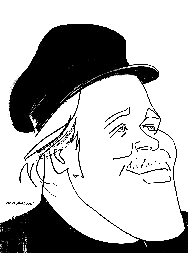
|
|
| Caricature of Glenn Loney by Sam Norkin. | |
At the Guggenheim Museum: *
DAVID SMITH: A Centennial *
At the Museum of Modern Art/MoMA: *
ON-SITE: NEW ARCHITECTURE IN SPAIN *
EDVARD MUNCH: *
The Modern Life of the Soul *
PIXAR: 20 Years of Animation *
WITHOUT BOUNDARY: *
Seventeen Ways of Looking *
At the Jewish Museum: *
SARAH BERNHARDT: The Art of High Drama *
At the Frick Collection: *
GOYA'S LAST WORKS *
At the Asia Society in Its 50th Anniversary Season: *
A PASSION FOR ASIA: The Rockefeller Family Collects *
At the Metropolitan Museum of Art: *
ROBERT RAUSCHENBERG'S COMBINES *
ANTONELLA Da MESSINA: *
Sicily's Renaissance Master *
OPERA DEI PUPI *
Di Vincenzo Argento e Figli: Sicilian Puppet Crusaders at Met & Italian
Culture Institute *
At the New York Public Library: *
Re-opening of Newly Restored Lionel Pincus & Princess Firyal MAP DIVISION:
Beaux-Arts & Cutting-Edge! *
At the New York Public Library For the Performing Arts at Lincoln Center: *
SHOW BUSINESS! Irving Berlin's Broadway *
STORIES TO TELL: MASTERWORKS FROM KELLY COLLECTION OF AMERICAN ILLUSTRATION *
At the Rubin Museum of Art: *
HOLY MADNESS: Portraits of Tantric Siddhas *
At the Yale Universitry Art Gallery: Rare Gerald Murphy Canvas: Bibliothèque *
ILIJA: Naïve Art from Serbia *
ILIJA: His First American Exhibition *
Galerie St. Etienne *
At the Puck Building: *
Sanford Smith's 14th Annual OUTSIDER ART FAIR 2006 *
At the Cooper-Hewitt National Design Museum: *
FASHION IN COLORS *
At the Guggenheim Museum:
DAVID SMITH: A Centennial
[Closing May 14, 2006]
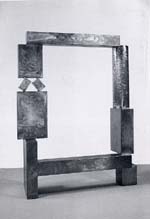 |
| Cubi XXVII by David Smith. Photo by David Heald. |
For once Frank Lloyd Wright's ascending/descending ramp in the Guggenheim Museum's grand Rotunda is an ideal flowing-space in which to exhibit art-works. But this is because they are not paintings, but a grand retrospective of the welded-steel sculptural achievements of David Smith, notably from 1945 to 1965.
As Smith trained as a planar-artist/painter-sketcher, before he began attaching objects to his paintings, and later, when he was painting his metal-weldings, he was early confronted with the question whether he was a painter or a sculptor.
Actually, he did refer to his explorations as "drawing in space." A recent review of the current show takes him to task for this apparent failure of vision, suggesting that his metal-sculptures still look like planar-works, rather than taking advantage of the three-dimensions that usually distinguish sculpture from painting and sketching.
This seems like an Academic quibble, worthy of fusty 19th century Parisian Salons. Smith's strange and often wonderful constructions range from early suggestions of satiric figurativism to his monumental Cubi abstractions of burnished steel.
Early influenced by Cubism, Constructivism, and Surrealism, Smith evolved his own vision of Abstract Expressionism, becoming a powerful influence on sculptors of his own generation and after.
Despite his initial training as a painter, there was a brief parallel-training as a metal-worker, when he was at work in a factory at 19. During World War II, he was helping defeat the Axis Powers by welding locomotives in a factory.
So David Smith learnt the craft of welder/metal-worker from the ground-up. But he had the gift, looking at a pile of metal-rods and angle-iron, to see an artwork emerging, rather than the chassis of a locomotive.
His "sabbatical" among the abandoned tools and iron-scraps of a defunct Genovese/Voltri welding-factory inspired some very powerful works, some of the best of which are on view at the Guggenheim. Smith created 27 metal sculptures in 30 days! But it's a bit sad to see actual blacksmith's tools welded into a frozen metal evocation of Forging Metal.
[That's a personal reaction, however: most viewers will have no idea they are looking at real tongs. But my grandfather made his own blacksmith-tongs, hammers, & clippers in Gold Rush California, and my farmer/blacksmith father continued to use them. Until it was cheaper to buy horseshoes at the local Nevada City Alpha Hardware Store. And there's no room in a Manhattan apartment for forge, bellows, & cumbersome old iron tongs…]
Those who have been able to enjoy Smith's sculptures out in the meadows of his Bolton's Landing home & studio swear that is/was the best way to see them. But his metal-oeuvre is now so Iconic and Valuable that dealers and curators don't want to leave it out in all weathers. One of these pieces could now buy the whole farm!
At the Museum of Modern Art/MoMA:
ON-SITE: NEW ARCHITECTURE IN SPAIN
[Closing May 1, 2006]
 |
| Valleacreon Chapel in Cuidad Real by Sol Madridejos and J.C. Sancho Osinga |
Thanks to the increased—and much more attractive—exhibition-spaces at the New Improved MoMA, it is now possible to have even more shows than before. But some recent survey-shows have been so impressive that it's a shame they could not have stayed longer.
Hardly had the remarkable Santiago Calatrava show settled in than it was replaced by On-Site, an unsettling exploration of new architecture in Spain. Note that the sub-title is not New Spanish Architecture, for not all these innovative projects are by native Spaniards. Conversely, although he is Spanish, a number of Calatrava's most notable projects were designed for sites beyond Iberian borders.
[When will Portugal be given Equal Time? One of its most fanciful constructions is, however, also by Calatrava: The Oriente Station, created for the Lisbon World's Fair.]
For some advocates of Historical Preservation, there is a real problem about plunking down an audacious Post-post-Modernist architectural-confection in the midst of a Medieval Enclave, or even an 18th century residential-block. One of the projects on view does exactly that—and it looks out-of-place, disorienting.
Nonetheless, over the centuries in major European cities, new architectural styles have wedged themselves between older structures. Often, this simply visually enriched the block, as the style's effect was usually limited to the façade, not to the shape or volume of the new building, although it might well have an innovative finial summit.
Baron Haussmann solved the problem of the New clashing with the Old by destroying the heart of Medieval Paris, to replace it with his broad new boulevards and what was, for its time, modern architecture, rooted in classicism.
Some of the new projects on view at MoMA show to great advantage because they are not shoe-horned into older tracts or enclaves. A number are so sculpturally surprising that they profit from being free-standing, surrounded by plazas, terraces, or even water-reflectors.
Frank Ghery's projects have their greatest effect when set apart. Nonetheless, his disorienting new construction in Prague, oddly enough, fits right into an older context. As does the daring Hass Haus in Vienna, whose glass-façade reflects the Medieval St. Stephen's Cathedral!
Actually, Catalonian architects showed—way back in the mid-19th century—how astonishing confections of Catalunyan design could be integrated into older blocks. And Barcelona' Modernisme was not merely a matter of novel façades. With Antionio Gaudi's Casa Milà, the basic-structure and interior-spaces were also revolutionary.
At MoMA, stunning new projects are presented both in models—which are often artworks in themselves—and in huge photo-blowups. Among the most outstanding visually are Richard Rogers' Barajas Airport Terminals in Madrid, Jürgen Mayer's Metropol Parasol in Seville, Sancho-Madridejos' Valleaceron Chapel in Ciudad Real, and Miralles & Tagliabue's Santa Caterina Market in Barcelona.
Not on display, of course, is Frank Ghery's Bilbao Guggenheim Museum. By now, it is Old News.
What is especially interesting, however, about all this new and often cutting-edge innovative architecture is that a number of projects are for very old towns and cities that are virtually unknown on the Tourist-Trail.
Why did their City Fathers decide it was time to update and innovate? Surely the Lesson of Bilbao and the Ghery Museum taught them something. Who ever heard of Bilbao before—except in that Brecht/Weill theatre-song…
A new City of Culture in Santiago de Compostela? The Holy Bones of Jesus' Brother, St. James, must be revolving in his sarcophagus-shrine!
Most of the projects on view are by Spanish architects and partnerships, but Zaha Hadid, Dominique Perrault, Toyo Ito, Herzog & Meuron, David Chipperfield, and Jean Nouvel, among others, are also represented.
[Closing May 8, 2006]
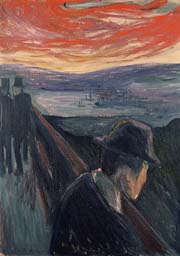 |
Many who are familiar with that famous—even ubiquitous, in life-sized balloon-blow-ups—haunting, horrendous image of an almost skeletal face, mouth open in an extended vertical 0, hands held over ears, standing on a long wooden bridge, beneath a menacingly colored & striated Scandinavian sky, may not even know who the artist was who created this Iconic Image.
Some surely do not even know that it is titled: The Scream. Even those who know its given-name may not know it was imagined and called into being, in 1895, by the challenging Norwegian artist, Edvard Munch.
But it is only one of Munch's often mysterious lithographs, drawings, and paintings now on view at MoMA—which will be the only venue of this arresting retrospective. Of special interest to theatre-fans are Munch's portraits of August Strindberg and Henrik Ibsen—an especially dark vision. He also painted his own image, evolving over time.
In fact, a number of the works are clearly very close to Munch and his spiritual broodings, his family, and the often bleakly-viewed rural Norway that he so loved. Some seasons ago, in a touring show called Northern Light, selected Munch canvases demonstrated luminously that the Light is indeed different in Scandinavia. Ingmar Bergman also evoked that in his film, Winter Light.
Among the notable Munch works now on display at MoMA are Summer Night's Dream, Ashes, Melancholy, The Dance of Life, Evening on Karl Johan Street, Girls on the Pier, and the oddly impressive The Yellow Log.
Munch's same Scream bridge—and similar skies—are revisited in Despair and Angst. If you had to live through a long sunless Norwegian Winter in the late 19th century, you might also be filled with fear and despair: such emotions could easily trigger a Scream!
In the lithograph, On the Waves of Love, a haunting woman's face, surrounded with flowing hair, seems to be drowning under that very Angst-ridden bridge:
Although Norwegian scenes, customs, and natives are paramount—certainly at his studio-museum outside Oslo—Munch was obviously influenced by evolving modern trends in Paris and Berlin. If there is one German artist whose works seem akin to some of Munch's, it is Munich's Franz von Stuck. Munch's Madonna seems inspired by a similar nude female torso of Stuck's: Die Sünde. Or perhaps the inspiration was from Munch to Stuck.
In any case, when you are in what used to be Christiania—when Norway was ruled by Denmark—do visit the fabulous Munch Museum. When in Munich, do not miss the Secessionist-Neo-Classicist Jugendstil Villa Stuck either.
[Many years ago, when the historic seaport town of Bergen was having its 800th Anniversary, your scribe was invited to take part—the only American journalist on hand. This included a State Dinner, with the King of Norway presiding, as well as a thorough photographing of the National Theatre where a young Henrik Ibsen had his theatre apprentice-ship.
[But the Norwegian government also insisted I sample reindeer with ligon-berries and visit the Edvard Munch Studio-Museum outside Oslo. I photographed all the artworks—a number of which are now on view at MoMA. Nor did I miss Edvard Grieg's studio-home or the Sonia Henie Art Museum. Who now remembers this champion Norwegian skater and movie-star? I don't really remember the correct spelling of her name: is this right?]
[Closed Febrary 6, 2006]
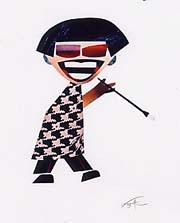 |
| Edna Mode (aka "E"), The Incredibles Collage by Teddy Newton |
Unfortunately, this delightful PIXAR show has already closed—it could have become a Permanent Installation, a constant delight to kids and adults alike. Manhattan fans of The Incredibles were amazed to see the models of the characters and objects used in the animated film.
Pixar's ingenious and innovative chief, John Lassiter, was on hand for the press-preview. His explanations of various visuals in the show were most instructive.
One wall-sequence looked at first like a story-board, but Lassiter pointed out that, although it showed progressive scenes in the projected film, it was, in fact, a color-board, to establish dominant colors in various scenes, depending on their emotional content.
Several flat-screen monitors showed various backgrounds for such films as Toy Story, A Bug's Life, & Finding Nemo, in rotation.
In addition to actual story-boards, there were sketches of such animation-idols as Buzz, Frozone, Sullivan & Mike, Luzo, Anglerfish, and famous Fashionista, Edna Mode.
In a separate installation, Pixar showed its Giant Zoetrope with myriad 3-D Toy Story figures. Rapidly revolving under strobe-lights, the figures seem to move. This could be a new Major Attraction for Theme Parks. As Pixar & Disney are now wed, the time may be just right to develop this fascinating show.
Pixar's ARTSCAPE has similar potential: it is a wall of fantastically changing images and moving figures. Like the world's biggest TV screen—in your own home!
Lensing this show, I photographed a small model for the overweight, desk-bound hero of The Incredibles. As well as some shots of John Lassiter explaining the artworks. Placed side-by-side, Lassiter looks like the model for Our Incredible Hero!
Good News! Based on the MoMA show, PIXAR is going to tour widely. Possibly in venues like that endlessly roving STAR WARS show—which I saw first at SF MoMA, not far from the Lucas Ranch.
[Closing May 22, 2006]
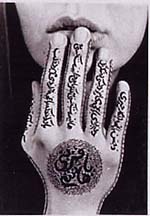 |
| Untitled by Shirin Neshat. Courtesy of the artist and Gladstone Gallery. |
Had this odd show been limited to new works of art by Muslims & Islamists living and working in those Middle Eastern, African, and Asian lands where Sunnis, Sufis, Shi'ites, Ismaelis, Wahabbis, and other sects of passionate followers of the Prophet Muhammad—Blessed be his Name—and the Holy Koran hold sway, it would surely have had a rather different iconic-look.
Inspired by the ancient Jewish Commandment against Graven Images, in Islam, the creation of images or artworks that feature humans, animals, birds, or even fish has long been forbidden. Instead, elaborate Calligraphies—often involving scriptures from the Koran or evoking the Name of Allah—or elegant & intricate Geometric Designs have been favored for centuries, influencing the production some amazing works of art.
A notable historic exception, of course, are those delicate Persian miniature-illustrations. Or those created in Rajasthan, where Shah Jahan and his lovely wife, Mumtaz, are shown playing chess with the Taj Mahal in the middle-distance. As this famous shrine was her mausoleum, it's unlikely she could have seen it in all its glory while still alive. Unless the Shah got an early start on construction…
[Nonetheless, when I was working in Sa'udi Arabia—in Dharan, Hofuf, Abqaiq, and Ras Tanura—every classroom and office had a photographic portrait of the old King, Ibn Sa'ud. The national flag and other emblems of Sa'udi Supremacy featured only palm-trees and crossed-swords. No Human Faces. My queries about the photos were explained thusly: Photos are not graven-images, which are made of wood or stone. Oh…]
At MoMA, there are no such restraints imposed. Most of the artists who were born in Muslim lands now live abroad, London and New York being favored ports-of-call. And, of course, Bill Viola and Mike Kelly are not Middle-Eastern fugitives.
But Kelly has been inspired by Islamic designs to imagine an artwork wall-carpet, woven of silk in Iran. Instead of a geometric-device pointing toward Mecca, he has a good old Irish Shamrock at the center of his prayer-rug. Is this the iceberg-tip of the Clash of Civilizations?
Woven carpets are also created by Shirana Shahbazi—born in Tehran, now working in Zürich. Her woven wool & silk series of Flowers, Fruits, and Portraits carpets are so photographic in detail that some Purists might be tempted to call them Kitsch.
One of the most ingenious ideas of adapting Muslim calligraphies & designs is provided by Istanbul's Kutlug Ataman, with three black screen-monitors featuring elegant duplicate but reversed white calligraphic designs that revolve on screen to reveal ever-changing patterns.
Other innovative Islam-Influenced artists on show include Mona Hatoum, Y. Z. Kami, Shirin Neshat, Shazia Sikander, Raqib Shaw, & Marjane Satrapi.
SARAH BERNHARDT: The Art of High Drama
[Closing April 2, 2006]
In her time—extending into America's Jazz-Age—Sarah Bernhardt was the most famous actress in the world. Although she always played in French, she nonetheless captivated American audiences with repeated tours—nine of them—of French classics and works written especially for her by Edmond Rostand and Eugène Scribe, like Tosca. She reached the widest possible audiences across the nation by appearing even in Vaudeville in short scenes.
Shut out of Syndicate Theatres, Bernhardt even toured the United States playing in a tent! She gave special performances after the San Francisco Earthquake for the benefit of the survivors.
Her Death Scenes were especially popular, both at home and abroad. She never died the same way twice, it was said. She titillated her foreign fans by traveling with her own coffin—in which she was occasionally photographed.
Bernhardt immediately saw the potential of Thomas Alva Edison's invention of the phonograph: she was among the first to record her famous Voice of Gold. She also embraced his invention of Motion-Pictures, so that some of her film-performances are the only visual record of Bernhardt in action.
The handsomely-designed exhibition at the Jewish Museum—la belle juive Bernhardt was Jewish, although later a Catholic convert—is a model of dramatic presentation of lavish costumes, stunning & precious jewelry, romantic memorabilia, unusual artifacts, powerful paintings, archival production-photos, sculptures, letters, programs, and posters—notably those Art Nouveau collector's-items of Alphonse Mucha: Médée, La Tosca, Lorenzaccio, Gismonda, La samaritaine, and, of course, Hamlet.
Bernhardt was a sensation playing "Breeches" roles. That there was more than a little of the masculine in her may be intuited by the fact that one of the two great loves of her life—she had many affairs—was the talented artist Louise Abbéma. Companion relief-portraits that the lovers made of each other are most tender and impressive.
But then Bernhardt was herself a gifted painter and sculptor. It was a second career, forgotten by most theatre-historians, who have had enough to keep tabs on with her theatre-life alone.
Bernhardt was a very shrewd manager of her talents—as this exhibition makes clear—buying theatres, commissioning plays, managing tours, and promoting her personality and performances with ingenious and totally artistic advertising-campaigns. And, yes, she was not above lending her name and legend to commercial products!
This show is not to be missed: it is not traveling. If you want to savor the essence of La Belle Époque in Paris, with the Divine Sarah at its center, This Is The Place. [Personal Disclosure: One of my two Senior Thesis topics at UC/Berkely was on Mme. Bernhardt. The other was Max Reinhardt, also a great Jewish genius of theatre!]
And, when you next go to Paris, you might want to see a show in the theatre named for her: Le Théâtre Sarah Bernhardt!
[Closing May 14, 2006]
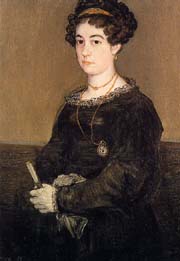 |
| Portrait of a Lady (Maria Martinez de Puga?) by Francisco de Goya y Lucientes |
Not only did Spain's brilliant Francisco de Goya y Lucientes have the major misfortune—like Beethoven—to become deaf at the height of his artistic powers, but he also cherished liberal social and political views that were sharply at odds with the Bourbon Kings of Spain, under whom he long served as Court Painter.
Nonetheless, three of these Bourbon Monarchs prized his talent and continued to subsidize him. Even when Napoleon conquered Spain and put his feckless brother, Joseph Bonaparte, on the throne, Goya's position remained secure.
[Incidental Intelligence: After Napoleon's defeat at Waterloo and his definitive fall from power, some of the Bonapartes survived on a chicken-farm in New Jersey. It was also, for a time, a base for Mozart's librettist, Lorenzo da Ponte, who later taught Italian at Columbia College in Manhattan!]
With the restoration of King Ferdinand VII in 1823, brutal purges of Liberals were launched. Like German-Jews after 1933, those who could fled to France. With the permission of the king, Goya also went across the border in 1824. He found a new home among exiles in Bordeaux—also taking a trip to Paris.
But, by this time, he was very old and infirm. His hearing already gone, his eyesight was now failing. But the lithograph-crayon drawings he made at this time have proved especially powerful. As have the last portraits, the best of which are now on view at the Frick—in a small but potent exhibition.
The brutality of Spanish bull-ring encounters is almost impressionistically rendered in his lithographic crayon-sketches. It has even been suggested that Goya was, perhaps, the first Impressionist. Long before those Parisian painters…
Goya painted simple but very strong portraits of friends and benefactors in Bordeaux. Portrait of a Lady is already in the Frick Collection, Henry Clay Frick having acquired four Goya canvases.
Of special interest is his portrait of his admired friend, the Liberal Spanish playwright, Leandro Fernández de Moratín, also a fugitive to Bordeaux. For those who think the murderous excesses of the Roman Catholic Inquisition ended in the Middle Ages—with the Burnings-at-the-Stake of Jacques de Molay and St. Joan of Arc—the Spanish Inquisition was still active in 1824, targeting such authors as this brave dramatist.
Also arresting—though very small—are Goya's carbon-black & watercolors on ivory. One of these shows the two infamous women from the Golden Age Spanish classic drama, La Celestina: Maja and Celestina. The Maja looks lovely, but the old bawd is clearly an ugly, scheming whore-monger.
At the Asia Society in Its 50th Anniversary Season:
A PASSION FOR ASIA: The Rockefeller Family Collects
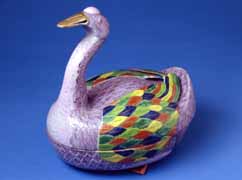 |
| ROCKEFELLERS COLLECT at Asia Society--GooseTureen & Cover |
[Closing September 3, 2006]
Considering that the foundations of the Rockefeller Family Fortune were originally pumped up from beneath the fields of poor Pennsylvania farmers, it may seem odd that, early on, especially the Rockefeller Women developed a deep and informed interest in the ancient arts of Asia.
Of course, the millions made from Standard Oil's drillings, refineries, and service-stations made possible a lavish lifestyle, complete with extended vacations in the Orient. The Asia Society, largely a Rockefeller benefaction—but not entirely—has long presented treasures from Rockefeller Collections at its Park Avenue museum/headquarters.
Now, for the first time, some of the most valued and unique of the Rockefeller Antiquities have been temporarily removed from various family homes and estates to be exposed to the public on Park Avenue.
On the museum's second-floor, the effort has been made to suggest how such objects looked when in a family-setting. There are large-scale photos of various Asian-Themed rooms and even Oriental Gardens as handsome as some historic artificial landscapes in China and Japan.
On the third floor, among golden Buddhas and gleaming Bodhisattvas, there is a magisterial 8th century stone image of Ganesh, the Elephant God of Hindu Myth. I noted to several colleagues that he is the Remover of Obstacles—a real Good Luck Charm.
A friendly guard nodded agreement: "When the maintenance guys have lottery-tickets, they rub them on his trunk!" Whether this activity has led to lottery-winnings I did not discover.
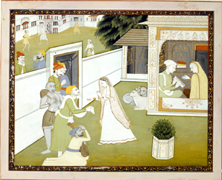 |
| A Lady Receiving
Musicians at her House.Photograph by David Robinson. |
Ganesh has certainly been metaphorically lucky for the Rockefellers, even though the dynastic-founder, John D. Rockefeller was a pious, severe Baptist. Although the neo-Gothic Riverside Church may look like an Anglican Cathedral, its roots are Baptist!
In the wake of the recent Art-Loot problems at the Getty Museum and the Metropolitan, several critic-colleagues speculated on the original provenance of some of the remarkable objects now on view—especially the Ganesh sculpture. Had they also been plundered? If so, how long ago?
This informative and entirely attractive exhibition has been co-curated by Adriana Proser and Asia Society President, Vishakha N. Desai. Both were adamant about the question of valid provenances, noting the care with which the Rockefellers chose their aquisitions-advisors.
Still, somewhere in India or Southeast Asia, there may be a temple-wall missing a chunk of 8th century elephantine-sculpture? Certainly, at various ancient sites in Thailand and Cambodia, there are scores of Buddhas and Bodhisattvas missing their heads. Not to mention the headless elephants…
At the Metropolitan Museum of Art:
ROBERT RAUSCHENBERG'S COMBINES
[Closing April 2, 2006]
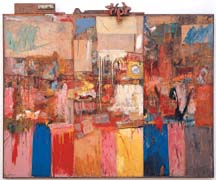 |
| Collection by Robert Rauschenberg |
It is absolutely amazing what an inventive artist can make out of Found Objects. As Robert Rauschenberg was one of the first to do this, it's entirely appropriate that the Met should showcase some 67 of his so-called Combines.
It could be said that he raised the Art of Collage to new heights, but that's not, in fact, what these unusual works are about
The Bauhaus genius, Kurt Schwitters, collaged flat bits of imagery, texture, and color onto planar-surfaces, but Rauschenberg went far beyond that. His flat surfaces have three-dimensional artifacts glued or nailed to them.
And there are a number of sizable free-standing works, such as that great horned Angora goat with a rubber-tire around its middle, standing on a base of some collaged image-strips and Rauschenberg's rough-scumblings of paint. This is called Monogram, and its image is on banners on every lamp-post near the Met. It is on loan from Stockholm's Moderna Museet!
To further elucidate—and place in proper contex—the significance & possible meaning of the Combines, the Met offers this explanation: "In these works, Rauschenberg reinvented collage, changing it from its role as a medium that presses commonplace materials to serve illusion into something very different: a process that undermines both illusion and the idea that a work of art has unitary meaning."
Well, that really says it all, doesn't it!
I could not have said it better myself, so I won't try to top curatorial verbiage.
And where did this idea that a work of art indeed has a Unitary Meaning come from? Are there not layers and levels of meaning to True Works of Art? Even those involving step-ladders, alarm-clocks, stuffed-roosters, and plaster-dogs?
These Combines span a decade, from 1954 to 1964. Among the master-works: Lincoln, Talisman, Honeysuckle, Small Rebus, Bed, Factum I, Gold Standard, Summerstorm, Magician II, Blue Eagle, Summer Rental, & Pail for Ganymede. Actually, some of these are mildly amusing in their mixtures of odd elements.
If the casual Met visitor is either astonished or appalled that anyone—other than cutting-edge Museums & Galleries—would have one of these oddities in his or her home, a number have been loaned from Private Collections, as well as from leading museums at home and abroad.
This may account for the show's International Tour, continuing through 2007. If you miss it here, catch it in Stockholm?
Not everyone can make an artwork out of some random Found Objects. David Smith—currently over at the Guggenheim—certainly had a few epiphanies, but much more restrained than Rauschenberg's.
Andy Warhol and Jean-Michel used to rummage through the trash-basket on my street-corner of a Sunday—Madison & 71st—retrieving the odd cookie-jar. But I often wondered what kind of Found Object Sculpture Andy might have made out of this junk, had he lived…
[Disclosure: I used to write for Andy Warhol's Interview, before it became cutting-edge famous & sophisticated.]
[Closing March 5, 2006]
Three of Antonella da Messina's masterworks now on view at the Met have never before been seen in the United States. What makes them especially important is his remarkable capturing of personal essences in these portraits. Much has recently been made of Memling's similar talents—at the Frick—but Da Messina's glowing faces are even more intimate and revealing.
The exhibition-centerpiece—confined to one chamber of the Met—is his Virgin Annunciate. Also on view, Madonna and Child with a Praying Franciscan Donor, with Ecce Homo on the verso, and Portrait of a Man.
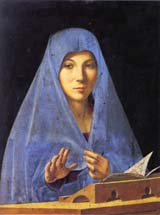 |
| The Virgin
Annunciate by Antonello da Messina |
Although a Sicilian, Antonella da Messina mastered his craft in Naples, at the Court of Alfonso of Aragon—these were the times of the Kingdom of the Two Sicilies, with the capital in Naples. Here, he was influenced by French and Netherlands artists. And his evolving mastery in turn influenced Bellini and others.
The Met says: "No greater artist emerged from southern Italy in the 15th century." And who are we to argue?
Also on view is the Met's own Da Messina oil, Portrait of a Young Man, plus a drawing of Christ Crowned with Thorns, and another double-sided panel from a private collection: Ecce Home and St. Jerome in the Desert.
Di Vincenzo Argento e Figli: Sicilian Puppet Crusaders at Met & Italian Culture Institute
In February, the Met Museum's exhibition of paintings by the Renaissance Master, Antonello da Messina, was saluted by a later Sicilian art-form, the Opera dei Pupi of Vicenzo Argento, which dates from 1891—a long way off from the Italian Renaissance.
Nonetheless, the Argento Family's shining silver Crusader-Knight puppets still keep alive legends of the Christian Heroes who went to the Holy Land to free Jerusalem from the Saracens. These tales were almost recent-history in the time of Antonello da Messina, so there is a connection, however remote.
At the Met, the Argentos performed The Battle of Orlando and Rinaldo for the Love of Angelica. Not quite the same fable as Jerusalemma Liberatta, but related.
At the Italian Institute, Vicenzo Argento demonstrated on some of the family's large-scale puppets how these rod-controlled—no marionette-strings—are constructed and how the gleaming armors and shields are carefully hand-crafted. These Crusaders look like silver-warriors, so it's appropriate that Argento is a verbal form of Silver!
At the New York Public Library:
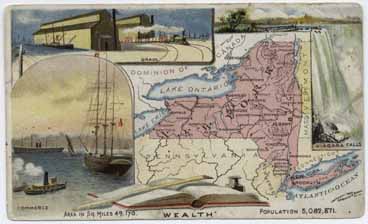 |
RESTORED
MAP ROOM at NYPL -- New York State |
[Permanent Installation]
It has cost the New York Public Library some $5 million to renew & restore the original Carrère & Hastings Beaux-Arts designs of the famed Map Room and stack-areas. The result is a glowing splendor of gold-leaf, polychroming, intricately carved wooden ornaments, and sharply-defined plaster-moldings.
Even if you have no interest in historic maps or contemporary cartography, the Reading Room's many splendors are not to be missed. But once there, you may be amazed to discover how almost everything you might want to know about maps—yesterday, today, and tomorrow—is now online. You can surf, study, and print-out.
If you are interested—or more-to-the-point, you are a Collector of hand-colored Historic Maps—not only does the Map Collection have many treasures to view, actual or online, but it also has a web-site that will tell you the latest prices of such maps at recent auctions worldwide!
There are some 420,000 maps and atlases in the collection. The renovations in the stacks have preserved some of the original stylized metal-castings for bookshelves, but, as most maps and atlases are much too large for conventional book-racks, large new sliding shelving has been installed.
At rest, computer-monitors in the Reading Room shimmer with the Logo of the New York Public Library's Online Catalogue: CATNYP! Talk about Cute!
At the New York Public Library For the Performing Arts at Lincoln Center:
SHOW BUSINESS! Irving Berlin's Broadway
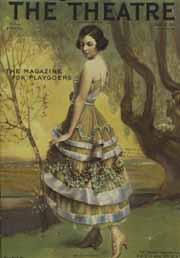 |
| IRVING BERLIN’S BROADWAY at Lincoln Center -- Irene Castle |
[Closing May 26, 2006]
Yes, Virginia, it's sad but true: they don't write great Show-Tunes anymore.
But, if you and Virginia would like to stroll down Memory Lane, enjoying the Easter Parade, you will be well rewarded with a visit to Lincoln Center and the Astor Gallery of the New York Public Library for the Performing Arts.
Show Business!—there's Nothing Like It, according to Irving Berlin's hit-song—celebrates Berlin's career in a text & illustration chronology that is attractively designed and easy to assimilate. Here are reproductions of posters & photos hanging from the ceiling, but there are plenty of actual posters & quarter-cards on view, as well as Al Hirschfeld caricatures, seldom-seen photos, original set-designs, programs, and cast-albums.
There are even sound-stations at which you can listen to show-songs as they were performed originally on the Broadway Stage. Barbara Cook & Russell Nype have also been on hand to celebrate. Cook presented a Master-Class with students from the Manhattan School of Music.
Among the landmark musicals saluted in this show: Annie Get Your Gun, Call Me Madam, Watch Your Step, As Thousands Cheer, This Is the Army, Miss Liberty, Louisiana Purchase, & The Cocoanuts.
But Berlin also composed for Hollywood films: scores for such movies as Top Hat, Alexander's Ragtime Band, Holiday Inn, Follow the Fleet, Blue Skies, White Christmas, and, of course, Easter Parade & There's No Business Like Show Business!
David Leopold deserves full credit for curating this historic show with such insight and affection.
STORIES TO TELL: MASTERWORKS FROM KELLY COLLECTION OF AMERICAN ILLUSTRATION
[Closing May 21, 2006]
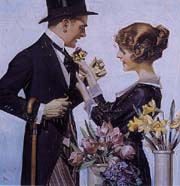 |
| The Florist by J.C. Leyendecker |
For some Painting-Purists, portraits in oils by Charles Dana Gibson or "historical" canvases by the likes of Howard Pyle or N. C. Wyeth, are beneath consideration as works of art. From some Super-Purists, they are even Beneath Contempt.
Do not mention the name of Norman Rockwell when speaking of Important 20th Century American Artists! Even though some of his most famous paintings—for Saturday Evening Post covers—not so long ago toured a number of American Museums…
Now some major canvases by Gibson, Rockwell, Wyeth, and Pyle are on display at the Dahesh Museum. Not to overlook those of Charles Montgomery Flagg, J. C. Leyendecker, Maxfield Parrish, Dean Cornwell, Harvey Dunn, & Jessie Willcox Smith.
As the Dahesh is largely devoted to Academic, Salon, & Figurative paintings and sculptures, this is a most appropriate venue for showing some treasures of the Kelly Collection of American Illustration.
The Artistic-Crime of these artist-illustrators was that they used their talents and skills to paint—not for museums, galleries, and rich patrons—but for popular-magazines, children's-books, and even—the Horror!—Commercial Advertising!
With the sleek, highly-styled Art Deco images of Leyendecker, however, it's clear that he regarded himself as a Consummate & Commissioned Illustrator. Not as a dedicated-artist, working in the Realist genre, with hopes of an exhibition and some sales to collectors.
The case of Norman Rockwell is very special: he became known as the Post Cover-man. All over America, each week people waited for the Saturday Evening Post to arrive in the mail. [Never on Saturday Evening, however.] What would be the comically-stylized subject this week? Santa Claus? The Pilgrims at Plymouth Rock? A Home-Hobbyist?
Millions of Americans wanted to enjoy Rockwell's latest sentimental "take" on American Life. Many saved the covers each week! Rockwell's World War II covers became posters, as did his visions of the Four Freedoms. His role in American Life & Popular Culture—during the tenure of the Post—made him an icon—as well as his pictures. He was much more than merely a stylish cartoonist.
For those old enough to have grown up with books of fairy-tales, medieval legends, and high-adventure, illustrated by Howard Pyle, it will be a real treat to see the originals of some of the best-known. My favorite Pyle book was The Wonder Clock, and one of its illustrations is here for all to see.
As also the paintings of Newell Convers Wyeth, here represented by The Boy's King Arthur, The Seal Hunt, & The King's Henchman. Despite his obvious visual skills, Wyeth was never accorded the artistic-status so generously given his son, Andrew Wyeth—not to mention his grandson, Jamie…
HOLY MADNESS: Portraits of Tantric Siddhas
[Closing September 4, 2006]
For Westerners whose knowledge of Buddhist Beliefs is largely limited to recognition of grinning big-bellied bronze Buddhas—or more sleekly svelte and serene Buddha-images with the hands held just so in ritual poses, often with lotus—it can be of real interest to learn more about other figures in the Pantheon. For instance, what about that Monkey King in Journey to the West?
At the Rubin Museum—which already has a remarkable collection of varied Buddha & Bodhisattva images on view—Tantric Siddhas are now in the spotlight. These mahasiddhas were legendary saintly tricksters who helped transfer Tantric Buddhism from India to the Himalayan Peoples.
Their magical, odd, eccentric, and unusual adventures are still celebrated in song and story. But they have also been immortalized in bronze figures, stone-sculptures, clay-images, painting, murals, and even in printed wood-blocks.
Some of the best of these are now on view at the Rubin Museum, formerly Barney's…
At the Yale Universitry Art Gallery: Rare Gerald Murphy Canvas: Bibliothèque
If you know anything about Gerald & Sara Murphy, it's apt to be that they were the glamorous "Lost Generation" American ex-patriates whose impressive homes in Paris and at Cap d'Antibes hosted Ernest Hemingway, Pablo Picasso, Igor Stravinsky, John dos Passos, Dorothy Parker, & Cole Porter, among other modernist artists and authors.
F. Scott Fitzgerald was so infatuated with them and their devil-may-care lifestyle that he modeled Dick & Nicole Driver on them for Tender Is the Night—and dedicated this fascinating novel to them.
What is less known, however, is that Gerald Murphy—who, as the Mark Cross heir, did not have to work or have a career—once abroad soon became an accomplished Modernist painter, favoring architectonic visions. But he painted for only a decade, producing some fourteen canvases.
Unfortunately—even though he was admired in his own time—in later decades, his name and his paintings lost the luster they had in the heyday of Hemingway and Fitzgerald. Perhaps that's why so few of them have survived. Some went at auction for a fraction of what they might have once brought.
Now Yale University Art Gallery has acquired a handsome painting by this Yale-alum: Bibliothèque. Stressing architectural verticals, stylized books, half a globe-of-the-world, half a magnifying-glass, and half a classical bust, the vision is severe but stunning.
Almost worth a trip to New Haven for itself!
But then there are all those other art-treasures on hand—not to overlook the Mellon Gallery across the street.
Incidental Intelligence: The Yale Gallery was founded in 1832, making it the oldest college art-museum in America. John Trumbull donated over a hundred of his paintings in that year. Some of these historical canvases magisterially recall the Nation's Founders and valiant encounters in the American Revolution.
First American Exhibition
At Galerie St. Etienne:
24 W 57th/NYC 10019
[Closing March 18, 2006]
Joseph Stalin would have had a fit: how dare a mere Yugoslavian Peasant paint wild fantasies of strange many-colored birds—and smugly smiling monsters with heads at both ends? Not only in the Soviet Union, but throughout the Warsaw Pact Nations, Socialist Realism was the standard.
Fortunately, Ilija escaped Joseph Stalin's notice. And also that of Josip Brosz—better known as Marshal Tito—Yugoslavia's own Stalin. As you can discover from Jane Kallir's report below, Ilija wasn't even a good Cooperative Farmer. The Communists took your land, your horses, cows, & sheep, and your wagons and tools away, and then expected you and your family to join your equally dispossessed neighbors in farming the Collective's Farm.
But Ilija was obviously a very special kind of Individualist in a Pluralist Society. It's fortunate that so much of his work has survived.
The current exhibition is dominated by Ilija's sometimes cartoonish fantasies, but there are other Yugo-Slavic artists on view as well.
Especially interesting among these works are what Germans call Hinterglasmalerie—painting on the back-side of a pane of glass. The colors have to be applied in reverse to achieve the desired effect when the other side of the glass is viewed.
Some of these works on view are almost sophisticated, but, in their origins, such glass-paintings were usually the work of peasant-artists, often as religious-images for the home.
[Your reporter has a very colorful 18th century Bohemian Hinterglasmalerie image, showing a crude but charming Sankt Florian pouring a bucket of water on a tiny burning church. If your neighborhood church catches fire, pray to Saint Florian: that's his speciality!]
For each new exhibition at the Galerie St. Etienne, the gallery's presiding genius, Jane Kallir, writes a very informative essay about the artists and/or genres on display. From its inception in Manhattan—after earlier incarnations in Vienna and Paris, both ended by the Nazis—the gallery has specialized in important 20th Century artists from Central Europe such as Egon Schiele, Gustav Klimt, Emil Nolde, and Käthe Kollwitz. This was a singular service after the Nazis spread across Europe, as few New York or American galleries were even minimally interested in such artists.
Because Ms. Kallir's foreword to the catalogue for the current Ilija exhibition is so incisive in its explanation of the cultural and political landscape of the former Yugoslavia—especially regarding the age-old hostilities between Serbs & Croats—she has given Curators' Choice her generous permission to reprint this valuable essay its entirety. Thank you, Jane Kallir!
ILIJA: His First American Exhibition
The artist now known simply as Ilija is one of the most enigmatic painters to emerge from the land formerly known as Yugoslavia. Born Ilija Basicevic in 1895, he received international acclaim in the 1960s and '70s under the pseudonym Ilija Bosilj. Despite his impressive exhibition and publication history, however, the Serbian-born Ilija was at the time somewhat overshadowed by the more heavily promoted "naives" from the Yugoslav republic of Croatia. Indeed, his work stands in sharp contrast to the Croatians' crisply rendered scenes of idyllic peasant life and farmland. Ilija's subject-matter depicts no recognizable world, but rather a nearly abstract parallel universe concocted by the artist from an amalgam of local history, myths, Biblical tales and imagination. Beyond the arena of squabbling "naives," "outsiders" and "folk" artists, Ilija stands alone, as puzzling as he is compelling.
The field of "naive" art originated in the early decades of the twentieth-century in part as a reaction to Western European industrialization, which was killing off rural folk-art along with traditional agriculture. At the same time, industrialization fostered feelings of alienation and a yearning for lost authenticity, which the bourgeois intelligentsia found in the work of lower-class painters who, often for financial reasons, had never dreamed of going to art school. Eastern Europe, by way of contrast, remained predominantly agricultural. In Ilija's hometown of Sid, some farmers had more land, more pigs and more sheep than others, but these peasants were all relatively equal in terms of education and occupation. The rifts that would come to divide them and eventually shred their entire nation derived less from the pressures of modern development than from centuries of history as a battleground between forces of the East and of the West.
Though Croatians and Serbs are all Slavic peoples who speak the same language, Serbia was incorporated into the Eastern Roman (Byzantine) Empire in AD 395, whereas Croatia was ruled by the Western Roman Empire. As a result, Croatia has since been predominantly Catholic, while Serbs tend to adhere to the Eastern Orthodox faith. Serbs are also distinguished by their use of the Cyrillic alphabet, introduced by the Greek priest Cyril in the ninth-century. In later centuries, the Ottoman Turks descended upon the Eastern territories of Serbia, while the Hungarians and then the Austrian Habsburgs took over much of Croatia. Sid, in the northwest Serbian province of Vojvodina, came under Austrian domination in the late seventeenth-century. The ever-shifting frontier separating the Christian West from the Turks was thereafter roughly twenty miles to the east of Sid, and local farmers were routinely conscripted by the Austrians to patrol the border.
Growing up in this contested terrain, where rule was always arbitrarily imposed from without, Ilija developed a fierce independence of spirit and a lifelong disdain for authority. As a boy, he dreamed of becoming a soldier, emigrating to America or apprenticing to a craftsman, but his parents needed his help at home, and so he stayed to take over the family farm. Drafted into the Austro-Hungarian Army in World War I, Ilija employed several subterfuges to minimize his service. Both he and his brother managed to avoid combat by repeatedly changing places and then running away. Subsequently, Ilija deliberately injured his leg so that he would be hospitalized instead of being sent to the front.
Despite these desultory military experiences, Ilija was not one to shirk his duty. He was an extremely hard worker, rising every day at 3 AM and tending his land and livestock until nightfall. A simple lunch of bread, bacon and onions was eaten in the fields; chicken was a treat reserved for Sundays. The men on Ilija's street owned a single pair of proper trousers among them, which they shared around for formal occasions. Nevertheless, Ilija was one of the more prosperous peasants in his little community, and he was proud. Although he himself had not gotten beyond the local elementary school, he was well-read and attuned to the latest advances in agriculture. Ilija hoped that his two sons, Dimitrije and Vojin, would receive university educations—something almost unheard of among the local peasant-class. But once again, politics and world history intervened.
After the demise of the Austro-Hungarian Empire in 1918, the South Slavic peoples ("Yugo-Slavs" in Serbo-Croatian) were united in the Kingdom of Serbs, Croats and Slovenes under the rule of the Serbian Karadjordjevic dynasty. However, this union quickly began to fray. In 1934, the Serbian king, Alexander I, was assassinated by the Ustase, a Croatian fascist group battling for complete independence. During World War II, the kingdom was taken over by the Axis powers, with Hitler controlling Slovenia, northern Croatia and Serbia, and Italy occupying southeastern Croatia and Montenegro. In cooperation with the Nazis, the Ustase soon began systematically exterminating Jews, gypsies and Serbs. The fascists made a particular point of targeting the wealthier and more educated peasants. In 1941, Ilija and a number of fellow-villagers were herded into the basement of the local church. Half this group was beaten and then shot by the banks of the Danube, while the other half, including Ilija, was released after a few days without further explanation. Following this narrow escape, however, it was clear to Ilija that his days in Sid were numbered. The Ustase's police-chief, who was married to a childhood friend of Ilja's, warned him and his sons to get out.
In October 1942, Ilija, Dimitrije and Vojin fled to Vienna, choosing that city because it was on a direct railway-line. There, they easily found work in an airplane-factory. However, after several months, Ilija was diagnosed with tuberculosis. Told he had only a few months to live, and worried about his wife and home, he returned to Sid, where he remained under regular surveillance by the Ustase. But before leaving, Ilija fulfilled one of his long-cherished dreams: he enrolled his two sons in the University of Vienna. Vojin and Dimitrije remained in Vienna until 1944, when they joined up with Tito's partisans to fight the fascist occupation of their homeland. While the partisans represented the only option available at the time, none of the Basicevic men really supported Tito's alliance with the Communists. Given their choice, they would have preferred to have the Serbian king back. And so, as the old kingdom was incorporated into the postwar Communist state of Yugoslavia, Ilija and his family once again found themselves at odds with the reigning regime.
Tito's brand of Communism was somewhat gentler than Stalin's: foreign travel was not impossible; collectivization was for the most part imposed not through brute force, but through extortionate taxation; dissenters were harassed, but less often sent to labor camps. Nevertheless, Ilija found himself under great pressure to join the local farmers' collective, because it was believed that, as one of Sid's more prominent citizens, he would serve as a role-model for the others. The political-police became a regular presence in his life, and he was repeatedly thrown into jail on trumped-up charges. Although he had recovered from his bout with TB, Ilija was no longer as strong as he had once been, and his sons finally convinced him to donate his land, horses and tools to the collective. Still, Ilija was as stubborn as ever: he refused to work the land that was no longer his, and so forfeited his share of the crops. Fearing starvation, his wife instead labored on the collective, while Ilija took care of their small home. Hereafter, they lived in near poverty.
In the meantime, both Ilija's sons had completed their university educations. Vojin had become a doctor, and Dimitrije an art-historian, critic, poet and artist (exhibiting under the pseudonym Mangelos). Ilija was not happy with Dimitrije's choice of profession, for he believed artists contributed nothing useful to society;
"hollow men," he called them. Regardless, Dimitrije was to introduce an important new element into his father's life. During the 1950s, Dimitrije worked as a curator in Zagreb at the Modern Gallery of the Yugoslavian Academy of Arts and Sciences, under the supervision of the artist Krsto Hegedusic. Dimitrije and Hegedusic shared an interest in the work of untrained peasant artists, whom they considered more vital than academic painters. Unfortunately, this shared interest was to develop into a bitter rivalry.
Just as "naive" painters were being "discovered" in Western European cities during the period between the two world wars, Yugoslavs had in the 1930s organized a group, called "Land," that united academically educated artists, including Hegedusic, with untrained peasant painters. After the war, Ivan Generalic was hailed as the most important self-taught member of this group. His hometown, the Croatian village of HIebine, became something of a Mecca for self-taught artists, who often emulated Generalic's method of painting on the backs of glass-panes, a technique that accentuated colors and produced clear, crisp lines. Self-taught painters—including Emerik Fejes, Ivan Rabuzin, Sava Sekulic and Matija Skurjeni—also emerged in other Yugoslav villages and towns. Unlike the Russian Communists, who took a hard line against any type of art that did not conform to their brand of Socialist Realism, Tito's regime allowed this home-grown "naive" art movement to flourish. Recognizing peasants as an important constituency, the Yugoslav Communists had secretly supported "Land" before the war; now they saw both an ideological counter to "decadent" foreign modernism and a potential export commodity in "naive" art.
As the Yugoslav "naive" movement gathered steam in the 1950s, Dimitrije Basicevic became one of its most important champions. He organized seminal exhibitions of such major figures as Fejes, Generalic, Rabuzin and Skurjeni, first at the gallery Peasants' Harmony (where he was co-director) and then at the Gallery of Primitive Art (which he co-founded in 1957). Increasingly, Dimitrije came to challenge Hegedusic's primacy as the instigator of the peasant artistic renaissance. In particular, Dimitrije questioned Hegedusic's claim that he had taught Generalic to paint. Given the nastiness of these professional squabbles, Dimitrije was dismayed when his father Ilija suddenly decided, in 1956, to join the growing ranks of peasant painters. Not only did this present an unneeded complication, but Dimitrije did not even like his father's work: compared to the exquisitely crafted, lyrical images of the Hiebine group, Ilija's paintings seemed crude and ugly. At first, Dimitrije actually destroyed some of them.
Ilija was not to be dissuaded from his late-life artistic vocation, however, and in time Dimitrije came to appreciate his father's paintings. Still, Dimitrije faced an undeniable professional conundrum. As the director of the Gallery of Primitive Art, he could not exhibit his father's work without being accused of a conflict of interest. And Dimitrije knew that Hegedusic, who had an extensive network of political connections, was just waiting to pounce on him. So Dimitrije came up with a plan that was as ingenious as it was, in retrospect, foolhardy: he instructed Ilija to conceal his artistic activities, and to disguise his artistic identity with a pseudonym. Thus Ilija Basicevic became Ilija Bosilj, taking his new surname from the Croatian island village of Bosiljna, where the family had a vacation retreat. Dimitrije s goal was to get Hegedusic to endorse Ilija's paintings on their merits, without knowing the artist's true identity.
Of course, Dimitrije's plan backfired. Ilija was not one to keep a secret, so it wasn't long before everyone knew he was painting. And Hegedusic went beyond accusing Dimitrije of conflict of interest: he declared that Ilija was a fraud. The paintings must have been done by Dimitrije himself, or by Vojin, or perhaps by some of Vojin's patients at the pediatric clinic where he worked. The entire Serbo-Croatian art world split into two camps, comprising accusers or supporters. Finally, Ilija was called to Zagreb, where he proved himself by painting in front of a tribunal of witnesses. Nonetheless, to publicly clear his name, Ilija had to sue the journalists who had denounced him; only after he had been vindicated in court did the press formally recant.
Although Ilija never received the wholehearted official backing enjoyed by other Yugoslav "naives," he did go on to exhibit extensively, not just in Zagreb and Belgrade, but in Western European capitals such as Amsterdam, Basel, Bucharest, Dortmund, Dusseldorf, Munich, Paris and Rotterdam. Ilija was also championed by the two leading scholars of European "naive" art, Anatole Jakovsky and Oto Bihalji-Merin. Bihalji-Merin, an internationally renowned art-historian who did much to promote the art of his native Yugoslavia, anointed Ilija as one of the most powerful and original of all the postwar "naives." In 1971, the year before Ilija's death, Sid established the Museum of Naive Art—Ilijanum to honor the work of its native son.
The Yugoslav "naives" benefited internationally from the same desire for authenticity that fueled the ongoing interest in Western European self-taught artists, but Yugoslav peasant painters were much closer to traditional folk-art than their counterparts in more industrialized countries. Reverse-glass painting, the technique favored by Generalic and his followers, was a craft historically used for devotional icons. Furthermore, the passing of the technique from generation to generation in Hiebine, while at odds with Western European notions of individualism, was in keeping with the communal nature of folk-art. In addition to religious icons and church decorations, Ilija's immediate artistic influences would have included embroidered towels and tablecloths, painted furniture and the woven wall-hangings used to insulate homes in winter. As or perhaps more important than any visual stimuli, however, was the largely oral tradition of Serbian folk-tales and history. The stories that Ilija told in his paintings were the same stories that he had told to his boys when they were growing up.
Given Ilija's avowed disdain for artists, it is hard to understand what prompted him to begin painting. His conflicts with Dimitrije over their respective artistic careers suggest that an element of father/son rivalry may have been involved. Ultimately, of course, it is impossible to know what drives any person to paint. What is clear is that, from the moment he first picked up a brush, Ilija was obsessed. He painted all day, with the same energy he had formerly devoted to farming. He painted far into the night, despite failing vision. He painted everything in sight: the walls of his cottage, the beds, the armoire, little scraps of wood and other chance objects. Professional materials—especially canvas and linseed oil—were hard to come by in Sid, so Ilija painted on whatever was at hand. A printmaker friend volunteered to produce an edition of silk-screens, but could not sell them; so Ilija painted over those.
Ilija's oeuvre can be loosely grouped according to subject-matter: there are Biblical stories, scenes from the Apocalypse, episodes from myth and history, depictions of local animals, birds and the Dzigura (Sid's main street), and most idiosyncratically, images of winged people and an idyllic parallel universe called Ilijada. These subject-groupings are not discreet categories, but rather are interrelated. The flying people are on their way to Ilijada. The Dzigura exists both on earth and in Ilijada. Overall, Ilijada is a paradise that balances and opposes the horrors of the Apocalypse. Given the evil that Ilija had witnessed in his own life, it is understandable that he was obsessed with such dichotomies. His paintings are full of double-headed and two-faced creatures, which represent dualisms, not just of good and evil, but of truth and lies, kindness and aggression, the conscious and the unconscious, the outer and the inner.
Ilija's symbolism is complex and at times obscure. For example, some of his paintings contain "keys" that represent flowers or refer to the female uterus, but it is not clear what doors or secrets these keys unlock. Animals often perform allegorical functions. The owl, conventionally, represents wisdom. Peacocks (a bird not entirely exotic in Sid, where one of Ilija's neighbors kept several) are ambassadors: enchanted princes from the time of the Serbian kings, or messengers from the perfect world of Ilijada. Depicting animals came naturally to the farmer Ilija, and their presence in his work further reflects the duality and interconnected-ness of the human and natural worlds. Ilija's paintings might best be interpreted as pictograms: employing a symbolic language to tell tales that defy explication in words.
In this, there are interesting parallels between Ilija's work and the art produced by his son Dimitrije. Taking the pseudonym Mangelos from the birthplace of a friend who had been killed in World War II, Dimitrije created paintings and globes covered with elegantly scripted words in many languages and colors. Mangelos's work (exhibited to great acclaim at the 2004-5 Carnegie International) is a metaphorical Tower of Babel, alluding to the ultimate impotence of language. Both father and son had lived through terrible events that belied any available philosophical or ideological rationale, and each artist attempted to grapple with the unfathomable in his work. Because Ilija was a self-taught peasant whose sources were the Bible and Serbian myths, he has traditionally been categorized as a "naive" artist. Yet his work amply evidences the inadequacy of such labels. "Naive," after all, suggests a lack of sophistication, but Ilija was looking to unlock the deepest secrets of life, the mysterious co-existence of good and evil.
[We would like to express our heartfelt thanks to Ivana and Vojin Basicevic; without their cooperation, graciousness and hospitality, this exhibition would not have been possible. Vojin Basicevic, in particular, has been a cherished resource, whose memories and astute understanding of his father's life and work form the basis of the foregoing essay. Copies of Dimitrije Basicevic Mangelos's book, My Father Ilija, may be purchased for $50.00, plus $15.00 for shipping and handling. New York residents, please add sales tax. Where applicable, checklist entries include inventory numbers and references to the Mangelos book.]
Your scribe & arts-reporter again wishes to thank Jane Kallir for permission to share this very informative—even remarkable—introduction to Ilija, his art, and the Grand Tormented Panorama of Serbo-Croatian History it provides. He hopes readers will agree that this essay is worth the entire February column. If you read nothing else… Jane Kallir has succinctly described the works on exhibition far better than could your correspondent.
Sanford Smith's 14th Annual OUTSIDER ART FAIR 2006
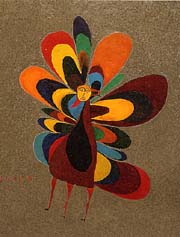 |
| The Enchanted Prince by Ilija |
Obviously, so-called Outsider Art has become Big Business. Abroad, this artwork is often called Art Brut, among other generics, but it's also identified here as Naïve Art, Intuitive Art, or Art of Untaught Artists. Do not imagine, however, that if you pick up a brush or a chisel—although also untaught—the results will be Naïve Art. You may well be consigned to that cultural-purgatory called "Sunday Painters."
Had Henry Darger only lived long enough to see his Naïve water-colors of naked & clothed Vivian Girls become fought-over Collector's Items! There was a time when his strange works were only on view at the Galerie St. Etienne. Now, a number of galleries are offering Darger Originals. And the American Folk Art Museum has an excellent collection— including his endless hand-written tales of his innocent little girls and boys—in its Henry Darger Study-Center.
There were a lot of Dargers for sale at the recent Outsider Art Fair at the Puck Building. But the religiously-inspired oddities of the Rev. Howard Finster also found their niche. And here were once again symbolic canvases of Simon Sparrow and there, the colorful designs from the Quiltmakers of Gee's Bend.
George Widener's 2005 Megalopolis is a fascinating vision of a mythic city, but Chris Hipkiss's metropolitan fantasies are rather more menacing, as In Europe Age Feral. Perhaps these are all too new to have the cachet of the remarkably complicated architectural fantasies of the Bay Area's A. G. Rizzoli.
Among the engaging artworks on view & sale were colorful visions by Ted Gordon, Nellie Mae Rowe, William Hawkins, Jim Work, Thomas Burleson, Joseph Wittlich, Elijah Pierce, Minnie Evans, & Paul Lancaster.
Being confined in a Mental Institution has proved no bar to artistic creation: Indeed, visualizing your Inner Demons on paper has proved effective therapy. And marketable as well! Under Hitler, Austria was a kind of madhouse, but long before, in the time of Sigmund Freud, there were plenty of troubled-minds. The Artists of Gugging win pride of place, and the artwork of Adolf Wölfli is especially interesting in this regard.
And what would an Outsider Art show be without some works by Anna Mary Robertson "Grandma" Moses? Unlike Henry Darger, she was fortunate to have been "discovered" in her own lifetime, complete with documentary-films!
This year, Japanese Naïve Artists were shown for the first time: Junko Yamamoto, Seiji Yamasawa, & Kunizo Matsumoto.
Oddly enough, however, there were not many Aussie Abo "Dreamtime" bark-paintings on view. [If or when you visit Arnhem Land in Northern Australia, you may want to buy your Dreamtimes painted on cloth, board, or card, as the bark deteriorates rather rapidly in over-heated American apartments.]
For the record, among the galleries showing their naïve wares—but hardly naïve in doing business: no bargains here: you have to go out into the Boonies and discover your own naives!—were Ames, Barbara Archer, Berenberg, Bonheur, Bourbon-Lally, Russell Bowman, Henry Boxer, Grey Carter, Cavin-Morris, Andrew Edlin, Carl Hammer, Marion Harris, Phyllis Kind, Maxwell, Pardee, Rising Fawn, Luise Ross, Tanner Hill, and, of course, Galerie St. Etienne.
Also on hand with its own booth was INTUIT: The Center for Intuitive and Outsider Art. These folks are way out in Chicago, Illinois! St.-Joan-of-the-Stockyards Country…
The Landmark Puck Building makes a welcoming venue for such art-shows, although there is nothing Outsider about the golden image of the top-hatted impish Puck over the main-entrance and high up on an edge of this late Victorian magnificence. Those old enough to remember William Randolph Hearst and his Sunday newspaper-insert: America's Comic-Weekly, may recall that the Puck image graced each issue, with the added legend—from Shakespeare: "What fools these mortals be!"
Sanford Smith & Associates offer a number of collectors' shows each year. Coming up is the 18th edition of WORKS ON PAPER, at the Park Avenue Armory, Park & 67th, from March 2 to 5. This is another Landmarked venue, but it is in danger as a future home for such shows as Book Fairs and Antiques Shows.
Despite the amazing attractions of its Late Victorian interiors—including the marvelous Louis Comfort Tiffany Room—and constant use by the US Military and various & regular annual-shows, it is seen as Under-Used. Apparently, the National Guard has no spare cash to preserve the exterior or properly restore the interiors. Nor does the State of New York. [And the Army Mess upstairs is not going to generate any profits from outside-eaters. The food is terrible…]
So the latest dumb-plan is to make the Armory into yet another PERFORMING ARTS CENTER. Something the Super-Rich on the Upper East Side really need right now—when, across town at the Met Opera, in Lincoln Center, there are scores of empty seats every performance-slot.
Where are they going to find audiences for the Armory Memorial Theatre?
There are already more than enough Cutting-Edge performance-venues. And even more defunct churches that can instantly also become PERFORMING ARTS CENTERs.
The evolution—or devolution—of BAM ought to be both instructive and cautionary. When Harvey Lichtenstein saved the handsome Herts & Tallants Brooklyn Academy of Music, he programmed avant-garde works by Robert Wilson and others, as well as importing important productions from major European stages.
This cost a LOT of money, but Harvey was a master of soliciting contribs from rich-folks, foundations, and corporations. Smoking may be bad for you, but Phillip Morris was always very good for BAM—even now, renamed as Altria…
He was able to keep the BAM Opera House, the Helen Carey Theatre, the LePerc Space, and an upstairs Dodgers' Theatre programmed most of the time. Later, he even added a nearby defunct Art Deco Era Movie-Palace, the Majestic—now called The Harvey.
But there was—and is—always a problem. Many Manhattanites did not seem to know where Brooklyn was. Or if you needed a Visa to go there.
Although you can get to BAM/Atlantic Avenue from Hunter College/68th Street on either the 4 or 5 subway express in half-an-hour—and equally easy from the West Side by subway—going out to Brooklyn for some potential spectators is still like trekking to New Jersey to the Paper-Mill Playhouse.
In the event, the Dodgers moved back to Manhattan. The Helen Cary became the Rose Cinema. The LePerc Space became a kind of bistro. Now, there are excellent—but sporadic—productions at the Harvey and the Opera House. And they cost a lot of money to import, although they play only a very limited number of performances.
BAM was supposed to be a cultural-anchor for the rebirth of downtown Brooklyn. Despite the presence of Long Island University & Pratt Institute—and Junior's Restaurant—this hasn't really happened yet.
Not least because Fulton Mall and the surrounding area is still mainly thronged with lively African-Americans who are not much interested in The High Arts, although BAM has reached out to them with Ethnic Dance & other minority-specific programs.
What once worked wonderfully at the Park Avenue Armory was the multi-space simultaneous-scene production of Tamara, an evocation of Art Deco painter Tamara de Lempicka's visit to Gabriele d'Annunzio's grand palazzo Il Imperiale. Catered, at the Interval, by le Cirque! But that was a one-shot usage. It wouldn't work tonight and every night.
At the moment, Broadway is so desperate for "Product," that they are reviving The Caine Mutiny Court-Martial, Barefoot in the Park, The Pajama Game, The Odd Couple, Sweeny Todd, Awake and Sing, & Three Days of Rain!
Ho-Hum…
At the Cooper-Hewitt National Design Museum:
[Closing March 26, 2006]
 |
| Pink ribbon costume, Viktor & Rolf, and Coat ("redingote") |
Although most of the striking—and, of course, COLORFUL—costumes on display at the Cooper-Hewitt are Western in origin, all sixty are from the collections of the Kyoto Costume Institute! This may invite some serious thought about our own dilatory interests in Preserving the Past & Archiving the Present. If Japanese museums are so focused on our own culture—as well as their own—what does this say about our museums and institutes in this regard?
[It's also worth noting that the current Bard Grad Institute exhibition on Propaganda in Clothing is largely drawn from Japanese collections! You never saw so many kimonos with Japanese Bombers & Tanks on them! Forget the Crysanthemums & Cherry-blossoms!]
At the Cooper-Hewitt, the unusual costume-designs range from the 18th century to the present and, in fact, include some stunning new Japanese designs. As fashion has generally—but not exclusively—been more female-oriented, most of the styles on view are intended for women. In some cases, obviously for very wealthy women indeed!
As an amateur-expert on Costume-History & Costume-Construction—a major-area in my Stanford University PhD in Theatre degree—I frankly found the cuts, the drapes, the stylings, and the silhouettes of most costumes in this Cooper-Hewitt show much more interesting than the actual colors of the fabrics used to construct them. In some cases, even the weaves and the materials used were as interesting as the colors.
But that is not the Curatorial-Thrust of this show.
Displayed on mannequins, the costumes are segregated by Color. In fact, as noted in museum-texts: "…six separate color-saturated schemes (black, multicolor, blue, red, yellow, and white), which emphasize and highlight the cultural, spiritual, and social associations often linked with each color."
You may well wonder what happened to GREEN in this Costume-Spectrum!
Obviously, "Seeing things in black & white" has had a wide, if not universal, currency. But colors do not have the same resonances and significances in all cultures, ancient and modern. The Cardinal Red of the Roman Catholic Hierarchy certainly doesn't register among Buddhist Holy Men. Nor do Saffron Robes really suit Methodist or Baptist pastors.
Although Black has been the color of Mourning in many lands for many centuries, it is now more often favored for High Fashions, "Basic-Black," and efficient Office-Wear. Sic Transit…
Curiously, White—symbolizing Purity in the West—is often the color of Mourning in Eastern cultures.
When purple-dyes were extremely rare and costly, they were often limited to Royal or Imperial robes. But, as modern chemical dye-stuffs were developed, even ageing Western ladies on modest budgets could indulge their secret passion for frocks in violet and purple hues.
Whatever their colors, these often unusual costumes are well worth a trek up Fifth Avenue, along Museum Mile! Some are downright bizarre—but nonetheless arresting—like Junya Watanabe's fluffy layered yellow skirt of polyester-organdy. Wearing it would be a real challenge, and sitting-down almost an impossibility…
Copyright © Glenn Loney 2006. No re-publication or broadcast use without proper credit of authorship. Suggested credit line: "Glenn Loney, Curator's Choice." Reproduction rights please contact: jslaff@nymuseums.com.